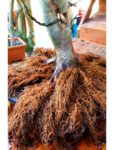MAPLE
Seedling
After trolling this forum for several months i decided to start my very own progression thread on my JM.
It has been a challenge keeping the foliage in good condition until winter however i believe im getting the hang of it. I live in Cape Town, South Africa so for those that have visited understand that it gets extremely warm and windy here for LONG periods so extra care must be taken to protect these beautiful trees. We have a VERY mild winters in comparison to most fowkes on here so i have zero need for winter protection.
Im relatively new the hoby so advice is very welcome!
I purchased this tree at a nursery for approximately R1500.00 (approx 105 USD). JM's of this age or any JM in SA are hens teeth!
I acquired this in 2016 Oct, the red unknown cultivar will have its own thread at some point

Since then i have air layered off two sections that that i sold off to enthusiasts which basically paid for the tree. WIN WIN

The base is a good start however i plan on improving it. in AUG 2017 it was repotted into a grow box where i was able to cut all downward growing roots, i will attempt thread and approach grafts at the next repotting to improve the root spread. Since JM's are so rare here I have taken several cuttings which are purposely grown and root trimmed for this grafting procedure . i will also need to thread graft a new leader at this time because everything above the base will be removed as result of the three trunks fusing together causing inverse tapper. This will be a long process however i'm excited about the journey.


This will be a single trunk tree however i began to enjoy the aesthetics of multi trunk tree and decided to start designing two trees on this single stock which should also contribute to speeding up the callous on the large cut. I used the Ebihara technique to reduce the risk of die back and speed up the process. The cut was made in mid August 2018 using a small ''bonsai'' saw, Dremel for final shaping of the wound then i re-cut the edges with a grafting knife.

further up the tree is the multi trunk design that i will air layer in Oct 2019.


It has been a challenge keeping the foliage in good condition until winter however i believe im getting the hang of it. I live in Cape Town, South Africa so for those that have visited understand that it gets extremely warm and windy here for LONG periods so extra care must be taken to protect these beautiful trees. We have a VERY mild winters in comparison to most fowkes on here so i have zero need for winter protection.
Im relatively new the hoby so advice is very welcome!
I purchased this tree at a nursery for approximately R1500.00 (approx 105 USD). JM's of this age or any JM in SA are hens teeth!
I acquired this in 2016 Oct, the red unknown cultivar will have its own thread at some point

Since then i have air layered off two sections that that i sold off to enthusiasts which basically paid for the tree. WIN WIN

The base is a good start however i plan on improving it. in AUG 2017 it was repotted into a grow box where i was able to cut all downward growing roots, i will attempt thread and approach grafts at the next repotting to improve the root spread. Since JM's are so rare here I have taken several cuttings which are purposely grown and root trimmed for this grafting procedure . i will also need to thread graft a new leader at this time because everything above the base will be removed as result of the three trunks fusing together causing inverse tapper. This will be a long process however i'm excited about the journey.


This will be a single trunk tree however i began to enjoy the aesthetics of multi trunk tree and decided to start designing two trees on this single stock which should also contribute to speeding up the callous on the large cut. I used the Ebihara technique to reduce the risk of die back and speed up the process. The cut was made in mid August 2018 using a small ''bonsai'' saw, Dremel for final shaping of the wound then i re-cut the edges with a grafting knife.

further up the tree is the multi trunk design that i will air layer in Oct 2019.


















